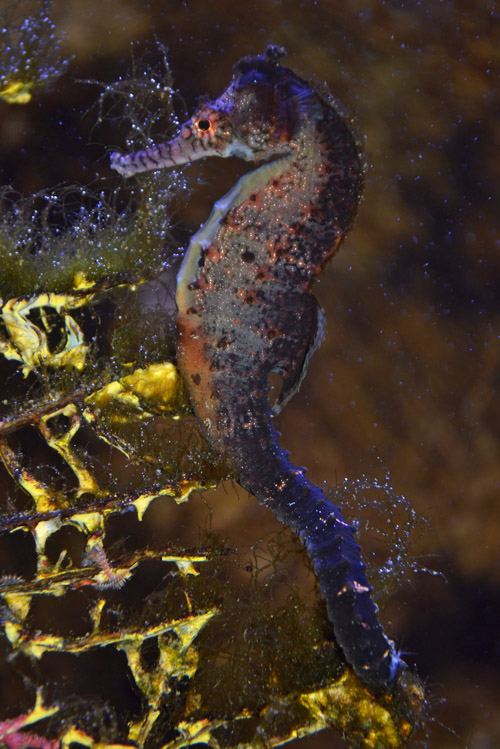Western Spiny Seahorse, Hippocampus angustus Günther 1870

A Western Spiny Seahorse, Hippocampus angustus. Source: Dave Harasti / http://www.daveharasti.com/. License: All rights reserved
A relatively large slender whitish, yellow, orange or brownish to greyish seahorse with a tall spiky coronet, a pattern of fine white, yellow, orange or brown scribbly or net-like markings and 5-6 distinctive dark irregular stripes across the snout. The dorsal fin has a narrow dusky submarginal margin band.
Western Spiny Seahorse, Hippocampus angustus Günther 1870
More Info
|
Distribution |
Endemic to tropical waters of Western Australia, from Shark Bay, north to the Dampier Archipelago. Inhabits sheltered algal-covered reefs and seagrass beds to about 10 m, although the species has been recorded from depths to 30 m. |
|
Features |
Meristic features: Dorsal fin 17-19 (usually 18); Pectoral fin 15-19 (usually 16-17); trunk rings 11; tail rings 32-35 (usually 33-34); subdorsal rings 2 + 1. Body slender; head angled downward from longitudinal axis of trunk; snout long, length 2.2 (2.0-2.5) in head length. |
|
Size |
Height to 160 mm. |
|
Colour |
Colour overall grey to brownish, often with a combination of white, yellow, orange or brown fine scribbly or net-like markings on the head and body; 5-6 distinctive dark irregular stripes across the snout; dorsal fin with a thin dusky submarginal line. In preservative - pale brown with thin dusky bars on snout and scribble markings on head and body. |
|
Feeding |
Unknown. Like other seahorses, this species presumably feeds by sucking small crustaceans and other planktonic organisms into its mouth. |
|
Biology |
The sexes are separate and it is the male seahorse that broods the developing young. The female deposits her eggs into an elaborate enclosed pouch on the abdomen of the male. He fertilizes the eggs inside the pouch and provides physical protection for the developing embryos. He also osmoregulates and aerates the embryos and may even provide some nourishment until the tiny young are born. The larvae are miniature versions of the adults and are independent once they leave the pouch. |
|
Fisheries |
Although H. angustus is taken as bycatch in commercial trawls, this species is not traded commercially. |
|
Conservation |
CITES Listed: Listed under Appendix II of the Convention on the International Trade in Endangered Species of Wild Flora and Fauna (CITES). |
|
Remarks |
Seahorses are very poor swimmers and rely on camouflage to blend in with their surroundings and avoid predators. |
|
Similar Species |
The Western Spiny Seahorse has been confused with Hippocampus histrix, H. spinosissimus and H. multispinus. |
|
Etymology |
Hippocampus is from the Greek, ippos = horse and kampe = curvature. The specific name angustus is from the Latin meaning narrow, presumably in reference to the narrow body of this species. |
|
Species Citation |
Hippocampus angustus Günther 1870, Cat. Fish. Brit. Mus. 8: 200, Freycinet's Harbour (Shark Bay, Western Australia). |
|
Author |
Dianne J. Bray & Vanessa J. Thompson |
Western Spiny Seahorse, Hippocampus angustus Günther 1870
References
Allen G.R. & R. Swainston. 1995. The marine fishes of north-western Australia: a field guide for anglers and divers. Western Australian Museum, Perth, Western Australia, 201 pp.
Foster, S.J. & A.C.J. Vincent. 2004. Life history and ecology of seahorses: implications for conservation and management. J. Fish Biol. 65: 1-61.
Günther, A. 1870. Catalogue of the fishes in the British Museum. 8: 1-549.
Hoese, D.F., D.J. Bray, J.R. Paxton & G.R. Allen. 2006. Fishes. In Beesley, P.L. & A. Wells. (eds.) Zoological catalogue of Australia. Volume 35. ABRS & CSIRO Publishing: Australia, 2178 pp.
Kuiter, R.H. 2000. Seahorses, Pipefishes and their Relatives. Chorleywood, UK: TMC Publishing, 240 pp.
Kuiter, R.H. 2001. Revision of the Australian Seahorse of the genus Hippocampus (Syngnathiformes: Syngnathidae) with descriptions of nine new species. Rec. Aust. Mus. 53: 293-340.
Kuiter, R.H. 2009. Seahorses and their Relatives. Aquatic Photographics, Seaford, Australia.
Project Seahorse 2002. Hippocampus angustus. In: IUCN 2008. 2008 IUCN Red List of Threatened Species. <http://www.iucnredlist.org/>. Downloaded on 09 April 2009.
Jones, A.G., C. Kvarnemo, G.I. Moore, L.W. Simmons & J.C. Avise. 1998. Microsatellite evidence for monogamy and sex-biased recombination in the Western Australian seahorse Hippocampus angustus. Molecular Ecology 7(11): 1497-1505.
Lourie, S.A., A.C.J. Vincent & H.J. Hall. 1999. Seahorses: an identification guide to the world's species and their conservation. Project Seahorse, London. 214 pp.
Neira F.J., A.G. Miskiewicz & T. Trnski. 1998. Larvae of temperate Australian fishes: laboratory guide for larval fish identification. University of Western Australia press, Nedlands, Western Australia.
Pogonoski, J.J., D.A. Pollard & J.R. Paxton. 2002. Conservation Overview and Action Plan for Australian Threatened and Potentially Threatened Marine and Estuarine Fishes. Canberra, Environment Australia, 375 pp.




